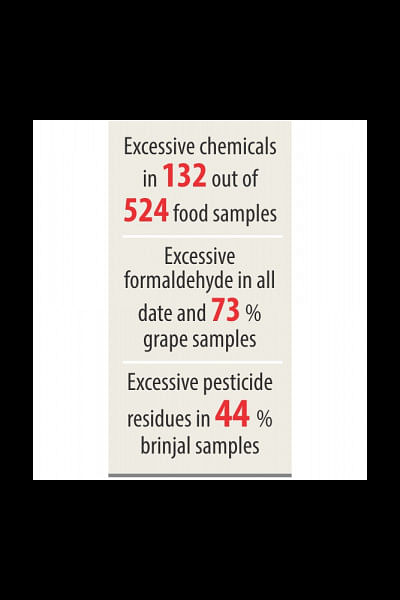Toxins in 9 food items

A chemical contamination study conducted by the government on 15 food commodities has found presence of excessive pesticide residues, aflatoxin, formaldehyde and hazardous colouring agents in one fourth of the samples tested.
The tests carried out between November last year and this June at the National Food Safety Laboratory (NFSL) at the Institute of Public Health (IPH) got presence of high level of harmful chemicals in many samples of nine food commodities. These food items are: Cauliflower, brinjal, green chili, amaranth, tomato, bean, grape, date and chili powder.
It is heartening, however, that the tests found all samples of six food items -- plum, bitter cucumber, turmeric, dried fish, parched rice and mango -- free from any toxins beyond Maximum Residue Limits (MRL).
IPH disclosed the food tests' outcome in a report, published this week, saying, "It is very clear that the presence of pesticide residues, colouring agents, formaldehyde in fruits and vegetables is becoming serious health and environment hazards due to indiscriminate use of these agents."
IPH carried out the tests at NFSL during the eight-month period (November 1, 2015 to June 30, 2016) on 45 samples of dried fish, 37 samples of grape and 27 samples each of the remaining 13 food items.
Out of 524 food samples tested, 132 were found out to be chemical positive, meaning those are harmful for human consumption.
And in most of the cases, there was presence of excessive pesticide residues.
Referring to a World Health Organization (WHO) estimate, the IPH report said there are three million global cases of acute and severe pesticide poisoning with some 220,000 deaths every year. The majority of these cases occur in the developing countries, it added, but could not offer any country-specific statistics on Bangladesh.
Presence of excessive formaldehyde have been found in 100 percent samples of date while harmful level of formaldehyde was also there in 73 percent of grape samples (in 27 out of 37 samples tested).
Of all other food items, brinjal turned out to be most susceptive as excessive pesticide residues have been found in 12 (44 percent) out of the 27 samples. Excess pesticide residues were also there in nine samples each of bean, green chili and grape, in eight samples of cauliflower, and three samples each of tomato and amaranth.
It came as a welcome relief as there has been no presence of formaldehyde or pesticide beyond MRL in any of the 27 mango samples tested. Further, on the positive side, no pesticide beyond MRL was traced in any of 45 dried fish samples tested and no urea was found in any of the 27 parched rice samples.
As many as 22 out of 27 red chili powder samples tested were found to be having excessive aflatoxin and three of these samples also had banned colouring agent Sudan Red.
Experts involved with the testing process showed one example to project the gravity of the food safety concern. They told The Daily Star that MRL of Quinalphos, a pesticide, is 10 part-per-billion (ppb) but, up to 128 ppb Quinalphos has been found in tested brinjal samples.
IPH Director AKM Zafarullah told The Daily Star that the eight-month survey was undertaken to analyse the concentration of pesticide residues, aflatoxin, formaldehyde and detection of colouring agents in selected vegetables, fruits, dry fish, and parched rice collected directly from farmers' fields as well as from wholesale and retail markets in Dhaka.
The samples collected from farmers were from Dohar, Keraniganj, Savar, Dhamrai, Kaliakoir, Gazipur, Kapasia, Ashulia, Narshingdi and Rupganj areas.
Samples at wholesale level were collected from Jatrabari, Karwan Bazar, Aminbazar, Tongi Bazar, Khilkhet Bazar, Mirpur-1 and Shyam Bazar while retailer-level samples were collected from New Market, Rajanigandha Bazar, Mirpur-6, Banani Bazar, Gulshan-1 Market, Uttara Rajuk Bazar, Mohakhali Bazar, Malibagh Bazar, Ashulia Bazar and Nakhalpara Bazar.
With supports rendered by the UN Food and Agriculture Organization (FAO), the National Food Safety Laboratory (NFSL) was established and subsequently declared as the national reference laboratory by the Ministry of Health and Family Welfare against a backdrop of parliament passing the Food Safety Act, 2013 on October 10, 2013.
The act came into being hard on the heels of a nationwide outcry against unbridled food adulteration. Long after the law enactment, the government formed Bangladesh Food Safety Authority (BSFA) in February last year with a promise to give consumers relief from toxin and adulterated foods.
But over a year and a half after the formation of the BSFA, its Chairman Mustak Hassan Md Iftekhar said they are still trying their best to play their mandated role but largely handicapped by non-sanction of required manpower.
The IPH report cautioned that "Long term accumulation of pesticide residues, aflatoxin and colouring agent in human body via dietary intake of vegetables and other food commodities is an alarming problem."
According to the WHO, pesticides are potentially toxic to humans and they may induce adverse health effects, including cancer, effects on reproduction, immune or nervous systems.
Aflatoxin is poisonous and children are particularly affected by aflatoxin exposure, which leads to stunted growth and delayed development. Formaldehyde can cause irritation of the skin, eyes, nose, and throat. High levels of exposure may cause some types of cancer, according to the United States Environmental Protection Agency (EPA). And according to the European Food Safety Authority (EFSA), Sudan Red is carcinogenic, meaning it has the potential to cause cancer.

 For all latest news, follow The Daily Star's Google News channel.
For all latest news, follow The Daily Star's Google News channel. 



Comments